Negative keywords are crucial for optimizing Google Ads campaigns.
They save budget, improve ad relevance and sculpt ideal traffic.
Without a strong PPC strategy, wasted spend and ineffective placements can occur.
This article dives into negative keywords, exploring six implementation strategies, hands-off vs. assertive approaches and platform-specific variations.
What are negative keywords and why do they matter?
Negative keywords are terms or phrases you intentionally exclude from triggering your ads.
When a user’s search query contains negative keywords, your ad won’t be shown, saving you money and ensuring your budget is allocated efficiently.
Below is an example of the search terms in a Google Ads account. This advertiser sells equipment to manufacturing facilities and does not want to sell to residential wood shops.
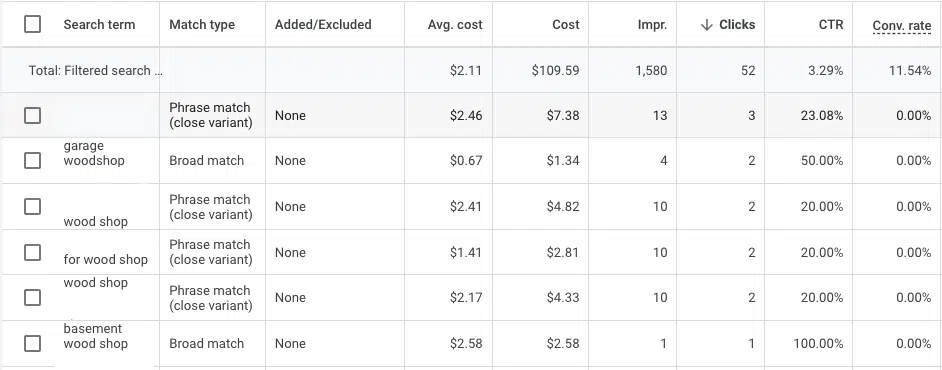

In the example above, the following terms would be added to the account as negative keywords:
- “Garage.”
- “Wood shop.”
- “Basement.”
Adding the keywords as phrase match would ensure that the ads do not show if the phrase is included in a user’s search query.
Negative keywords save advertisers money by reducing the chances of ads showing for irrelevant searches
Consider a campaign promoting a medical device for men. The advertiser wants ads to reach users genuinely interested in the product.
However, without negative keywords, ads are appearing for treatment and female queries.
Furthermore, users are clicking on the ads, which results in accrued costs for the advertiser.
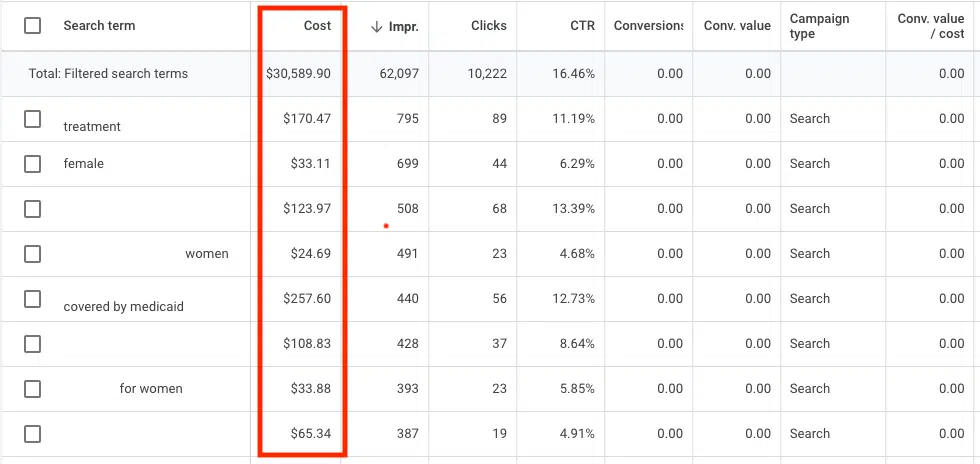

In the example above, the following queries should be added as phrase match negative keywords:
- “For women.”
- “Female.”
- “Covered by medicaid” (this product is not covered).
- “Competitor” (not shown for advertiser privacy).
- “Alternative product” (not shown for advertiser privacy).
The cost of clicks is closely linked to the quality of the ad copy in relation to your targeted keywords.
When your ads display for keywords unrelated to your brand, it impacts performance negatively.
Consider that search irrelevance can result in a lower click-through rate (CTR) and Quality Score, which can impact ad position and the cost of your clicks.
In simple terms, consider how Google perceives ads:
An ad with a good keyword-to-query alignment might cost $1 to $2 per click. However, an ad with poor keyword-to-query alignment might have a cost-per-click (CPC) of $5.
At times, the difference can be more noticeable. Therefore, incorporating negative keywords can influence the overall cost of campaigns.
Adding negative keywords reduces this cost, ensuring your budget is spent on more aligned terms.
Negative keywords can protect your brand
Imagine you sell toys for kids.
Negative keywords act as a shield, ensuring your ads aren’t displayed to those unlikely to convert.
For instance, excluding un-becoming terms like “cheap,” “dirty,” “dangerous” or “ripoff” can protect your brand from showing ads that reflect poorly on the brand.
Consider the example below. Could adding the negative keyword “ripoff” be a strategic decision for a few of the ads on the results page?


Traffic sculpting
Negative keywords can be applied at the campaign level to maintain alignment with the intended focus of the campaign.
For instance, in a competitor campaign, advertisers exclude brand keywords to uphold the campaign’s distinctive identity which is targeting users searching other competitor terms.
Similarly, when using a dynamic search ads (DSA) campaign to discover new keywords, it is advisable to exclude brand keywords at the campaign level to maintain the focus on new keyword mining.
Get the daily newsletter search marketers rely on.
Now that we covered the importance of negative keywords, let’s talk about six strategies to implement negative keywords.
Strategy 1: Identify known irrelevant keywords
These could be generic terms that don’t pertain to your product offering.
These can also be industry-specific jargon that doesn’t relate to what you provide.
For example, if you sell new electronics, you may want to exclude terms like “vintage,” “antique” or “used.”
You should also consider adding your competitors as negative keywords.
Strategy 2: Establish keyword thresholds
Create criteria that, once met, signal a keyword’s move to your negative list.
Examples include keywords that are costing you more than a certain amount without resulting in conversions or those that have accumulated a high number of clicks with no conversions.
You can fine-tune the thresholds’ timeframe or the thresholds themselves to either intensify or soften the approach when adding negatives.
Opting for a longer timeframe signifies a less aggressive strategy when incorporating negative keywords.
Whereas opting for a lower cost or a lower volume of clicks signifies a more aggressive approach to an account.


The picture above is an example of the timeframe selector in Google Ads.


This picture is an example of an extremely aggressive approach for adding a negative for any term that cost the advertiser money and did not convert.
Strategy 3: Ask tertiary questions about the keywords in the account based on secondary metrics
In some accounts, you may see queries with a lower CTR or conversion rate than other queries. You may also see queries that have a higher CPC.
Consider adjusting the match type rather than adding negative keywords for queries that have less than optimal secondary metrics.
If a query matches a broad keyword, changing the target keyword to a phrase or exact match can limit the range of matched queries.
Strategy 4: Employ search term reports
Leverage search term reports to identify actual user queries triggering your ads.
Look for those queries that generate a lot of clicks but don’t lead to conversions. Or look for queries that do not align with the advertiser’s intent or goals.
Each search term report can be a goldmine of potential additions to negative keyword lists.
During the Paid Search Association Webinar on March 28, 2024, there was a discussion about using the search term report to identify more negative keywords.
Chris Cabannis from Falcon Digital Marketing advised that adding negative keywords as phrase matches based on the report would save time.
The alternative method involves checking a box in the Google Ads interface to add negative keywords as exact matches. This default setting ensures only searches for those exact terms won’t trigger your ad.
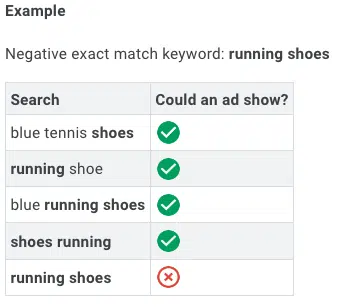

As shown in Google’s documentation, this method stops advertisers from being too restrictive. However, it requires repetition since the keyword order and plurality must match exactly to work.
Strategy 5: Block out undesirable phrases from the start
Think about protecting your brand’s integrity and ad relevance.
For instance, an educational institution might want to block terms like “fraud,” “cheating” or “easy A” to steer clear of search results that could harm its reputation.
A company that sells toys to kids might want to add negatives for “broken,” “dirty” and “dangerous” to remove any chance of ads being triggered.
Strategy 6: Add negatives that signal misaligned intent
Certain keywords may indicate intent that does not lead to conversions.
These can include:
- Interrogatives: Such as “when,” “where,” “why,” “what” and “who.”
- Information seekers: Including terms like “news,” “picture,” “image” and “update.”
Additional considerations when creating a negative strategy for paid search accounts
Bing matching is different and more aggressive
Unlike Google Ads, Bing’s algorithm requires a more proactive approach to negative keyword management due to its broader matching and potential for more loose associations in ad-serving.
Regular monitoring and frequent updates to your negative keyword list are crucial, when working in the Microsoft Advertising platform.
Review the negative match type factor
Negative broad match
Negative broad match keywords prevent your ad from displaying if the search includes all specified terms, regardless of their order.
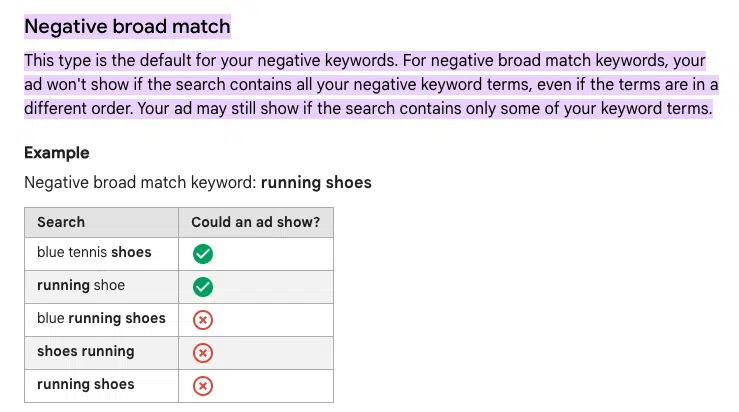

Negative phrase match
For negative phrase match keywords, your ad won’t show if the search contains the exact keyword terms in the same order.
The search may include additional words between the keyword terms.
The ad may still show even when the rest of the keyword terms are included in the search in the same order.
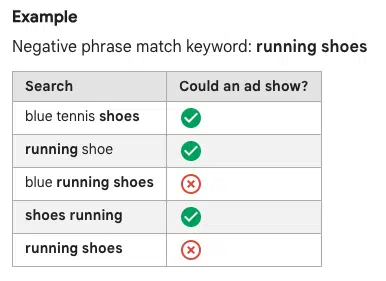

Negative exact match
For negative exact match keywords, your ad won’t show if the search contains the exact keyword terms, in the same order, without extra words.
Your ad may still show if the search contains the keyword terms with additional words.
The art of negative keyword creation lies in balancing excludability and specificity.
A negative keyword that is too broad could potentially filter out relevant traffic, while a niche-specific negative might not capture all variations of irrelevant searches.
Remember that close variants aren’t covered by negative keywords and search networks limit negatives to 10,000 per campaign.
Consider the overarching goals: Is the advertiser looking for efficiency or growth?
A client’s negative keyword strategy should differ based on whether they aim to increase revenue or enhance the efficiency of their marketing efforts. This is articulated in a comment on LinkedIn from Lisa Erschbamer.
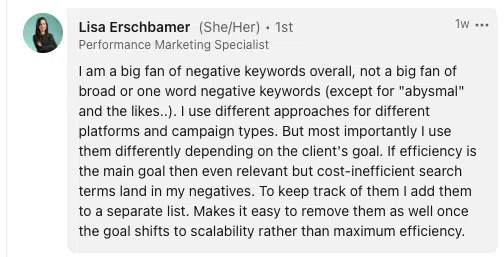

The amount of investment is another consideration when determining the approach to negative keywords.
Harrison Jack Hepp points out in a LinkedIn comment that advertisers with larger budgets can afford to learn that keywords aren’t performing as well. In contrast, a more aggressive approach works well for smaller budget accounts.
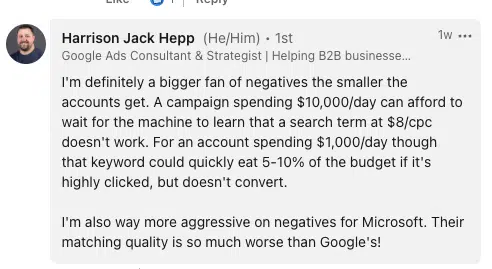

Negative keyword level and organization can help advertisers manage the strategy effectively.
Keywords can be added at the account level, the campaign level or the ad group level.
This Search Engine Land article goes into more detail about adding negative keywords at the account level.
It is worthwhile to include unwanted and irrelevant terms at the account level, as these terms are oftentimes set in stone.
While traffic-shaping keywords should be applied at the campaign level. Examples included adding the brand terms as negatives in non-brand campaigns or DSA campaigns.
This practice aids in better organization and allows the account to be managed strategically.
Another suggestion would be to add keywords that are more aggressive to a separate list and if an advertiser wants to grow revenue and leads these keywords can be removed.
Consider the vertical for the advertiser when approaching negative keywords
For local campaigns, excluding phrases that specify a location you don’t serve could be the difference between finding a customer and avoiding clicks out of market.
For ecommerce, negatives can filter out terms related to free, DIY or bargain keywords that might attract traffic seeking things other than what you’re offering.
Few golden rules for creating negative keywords:
- Use the search terms report regularly to identify irrelevant search terms.
- Keep your negatives updated as your campaigns evolve.
- Don’t be afraid to start with a few negatives and build from there – being too negative too soon can be detrimental when accounts are in a growth phase.
- Consider that humans are unique and while many paid search experts realize the power of the keyword, true intent often falls in keywords searched prior to taking the desired action.


Scott Carruthers responds in a LinkedIn comment, validating that humans aren’t necessarily logical in how they search, which aligns with the last point in the golden rules mentioned above.
Mastering negative keywords is an evolving process that requires a mix of data analysis and strategic creativity.
By monitoring your search query reports, understanding match types and applying negative keywords at different levels, you can customize your negative keyword strategy for your account.
Remember, your list of negatives should grow with your campaigns.
A strategic approach to negatives is an aspect of paid search that acts as a compass, steering accounts away from wasteful spending towards profitability.
Contributing authors are invited to create content for Search Engine Land and are chosen for their expertise and contribution to the search community. Our contributors work under the oversight of the editorial staff and contributions are checked for quality and relevance to our readers. The opinions they express are their own.



